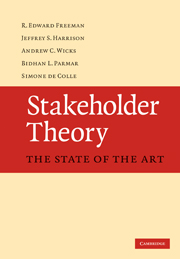Book contents
- Frontmatter
- Contents
- List of figures
- List of tables
- Acknowledgements
- Preface
- Part I The genesis of stakeholder theory
- 1 The problems that stakeholder theory tries to solve
- 2 The development of stakeholder theory: a brief history
- 3 Stakeholder theory, pragmatism, and method
- Part II Stakeholder theory and the traditional disciplines of business
- Part III Stakeholder theory, ethics, and corporate social responsibility
- Part IV Stakeholder theory: some future possibilities
- Bibliography
- Index
1 - The problems that stakeholder theory tries to solve
from Part I - The genesis of stakeholder theory
Published online by Cambridge University Press: 05 June 2012
- Frontmatter
- Contents
- List of figures
- List of tables
- Acknowledgements
- Preface
- Part I The genesis of stakeholder theory
- 1 The problems that stakeholder theory tries to solve
- 2 The development of stakeholder theory: a brief history
- 3 Stakeholder theory, pragmatism, and method
- Part II Stakeholder theory and the traditional disciplines of business
- Part III Stakeholder theory, ethics, and corporate social responsibility
- Part IV Stakeholder theory: some future possibilities
- Bibliography
- Index
Summary
We begin this chapter by outlining the problems that stakeholder theory was originally conceptualized to solve and the “basic mechanics” that we believe underlie the development of the theory during the last thirty years. We turn in the next sections to the arguments of Milton Friedman, Michael Jensen, Michael Porter, and Oliver Williamson, often cited as opponents of stakeholder theory, and suggest that all are compatible with the main ideas of stakeholder theory. We highlight what we also take to be key differences between stakeholder theory and these largely economic approaches to business. We suggest that while these approaches are compatible with stakeholder theory, it makes more sense to return to the very roots of capitalism, the theory of entrepreneurship. We suggest how stakeholder theory needs to be seen as a theory about how business actually does and can work. We make an explicit tie to the theory of entrepreneurship and outline the basics of the stakeholder mindset.
Stakeholder theory: the basic mechanics
Many have argued that the business world of the twenty-first century has undergone dramatic change. The rise of globalization, the dominance of information technology, the liberalization of states, especially the demise of centralized state planning and ownership of industry, and increased societal awareness of the impact of business on communities and nations have all been suggested as reasons to revise our understanding of business.
- Type
- Chapter
- Information
- Stakeholder TheoryThe State of the Art, pp. 3 - 29Publisher: Cambridge University PressPrint publication year: 2010
- 2
- Cited by



